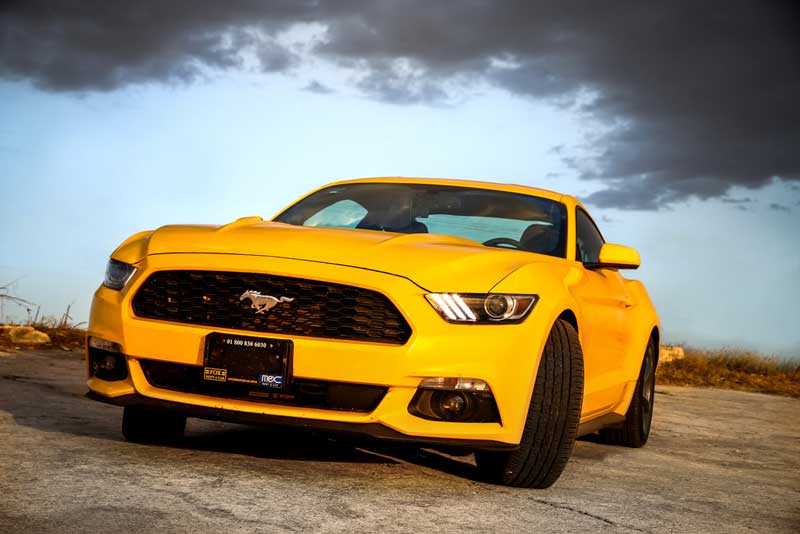One of the most well-known and enduring Ford nameplates is the mustang GT, a legendary sports and muscle car. However, you might want to know what is the Mustang’s actual travel speed. What year of the GT Mustang is the fastest?
If you have been thinking in these directions, then you are in the right place.
Over the years, the Mustang has had several sub-nameplates, including Bullitt, Mach 1, and Cobra. There are a few variables that affect the actual travel speed of the Mustang. This includes the model year, generation, editions, and engine.
This article will concentrate on GT-badged cars, covering the different generations, their speeds, and some frequently asked questions on this topic.
How Fast Can a Mustang GT Travel?
The top speed for Ford Mustang GT is **162 mph, and that is because of its 5.0L V8 engine. We trust that this satisfies your curiosity about the top speeds of Mustang GT, but as you are looking out for specs, wouldn’t you see how much you can save on your car insurance?
Ford Mustang Shelby GT500 of 2022 can go 0 to 60 in only 3.3 seconds and achieve a top speed of 180 mph.
The Shelby GT500 from 2013 and 2014 is the quickest Mustang GT, with a 202 mph top speed.
It was in the year 1982 that the GT badge was first used, and it has stayed around since. We’ll discuss every GT model and contrast the performance statistics to offer you a complete response to your question.
Remember that Ford has electronically been capping the maximum speed of several GT models for the past 20 years for safety measures.
Top speeds of several Sixth Generation Mustang GT versions Mustang GT by Ford
Production of the latest Mustang GT generation began in 2014 for the 2015 model year. The Shelby GT350, Shelby GT500, and the regular Mustang GT are the three available variations of the GT.
The Mustang GT 5.0L of 2015 – 2017 with a V8 engine produces 435 horsepower. A fresh engine 5.0L with a 460-horsepower output will be used from 2018 to 2021 for the model year 2022.
The Shelby GT350 is powered by the 5.2L V8 engine, producing 526 horsepower. In 2020 the GT500 Shelby returned but is now powered by a machine -5.2L V8, which is from the GT350 Shelby that has been upgraded and supercharged to produce 760 horsepower.

Ford Mustang GT of the Fifth Generation
In contrast to prior generations, the armada’s focal point is the GT, with many models bearing the special GT badge. For example, the 5th generation Ford Mustang GT ruled from 2004 to 2014.
The vehicle’s primary power source was a 4.6L 3- V8 SOHC Modular valve with 300 horsepower. The Shelby GT500, instead of that, utilized an iron block and aluminum heads valve of a 5.4L 4-V8 DOHC engine that was significantly more potent.
At 6,000 RPM, 500 horsepower was produced by Shelby’s engine, which was a significant power difference. Over time, both engines underwent constant revision and enhancement to have additional power and perform better.
The 4.6L V8 was replaced in 2011 by a 32-valve, all-aluminum 5.0L DOHC V8 engine. The recent 5.0L engine could produce 402 horsepower with ordinary gasoline or 412 horsepower with high-octane fuel. The Shelby GT500’s engine 5.8L Trinity V8 has also been upgraded and now produces 662 horsepower.
Ford Mustang GT of the Fourth Generation
The Ford Mustang 1993–2004 preceded the GT variant one year after its initial release. Compared with the 1993 Mustang and the prior-generation GT, the new vehicle has better performance and handling. Though the engine pushrod small-block V8 4.9L is back and is still designated as 5.0L.
The iconic GT was stripped down and reborn as Mustang GTS in 1995. The GTS was able to perform better by getting rid of all the extraneous parts.
In the same year that the pushrod V8, which had been manufactured in 1968, eventually phased out, engine SOCH V8 4.6L took its place.
Ford Mustang GT of the Third Generation
The GT brand would make its 13-year comeback in 1982 under the tagline “The Master is Back!” Windsor 4.9L V8 engine, the first of the new engines combined with the GT, was a standard model for the remainder of the manufacture.
A turbocharged 2.3L engine with fuel injection was also offered for the third-generation GT in 1983.
The updated V8 upgraded to a variety of port diesel injection technology in 1986, and the final carbureted Mustang V8 provided greater power. Until 1993, when the production of the V8 came to an end, it was continuously developed.
Also Read: Muffler Delete and Resonator Delete (Which is Better)
Ford Mustang of the Second Generation
Jumping to the next generation, the third, with no explanation of the pause from 1973 to 1978, would be strange. The age with the contentious design decisions was the second, precisely the engine choices, and did not use the GT badge.
The inefficient inline-4 and V6 engines of the 2nd generation Mustang initially caused a significant absence of power in the vehicle.
One year succeeding the vehicle’s debut, V8 was released to address the control issue. Still, the Windsor 4.9L’s 140 horsepower capacity limited its peak speed to 106 mph also its 0-60 mph acceleration time to 10.5 seconds.
Despite the engine’s somewhat more petite size of 4.9 liters, there is no doubt it pioneered the model that carries the badge 5.0L.
Ford Mustang GT of the First Generation
Formerly referred to as the Equipment Package of GT, the first Mustang GT debuted along with the basic model. Then, the GT’s power plant was a V8 with disk brakes, a grille-mounted fog lamp, a revised instrument panel, and rocker-panel stripes.
The performance numbers are identical to the ones of a standard Mustang because the GT was primarily a cosmetic upgrade at the time. Even two inline-6 engine choices, a 3, 3 L plus a 2.8 L thrift power, were offered for the GT.
Windsor V8 was produced in a HiPo (High Power) version and had a relocation of 4.7L or 4.3L.
Then, the engineering practice was to refine and enhance engine design annually. Finding precise performance figures is particularly challenging due to the enormous number of alternative power specs and the era of the invention, but I was able to locate reliable data.

What Year of the GT Mustang Is the Fastest?
What exactly makes an automobile the fastest sometimes needs to be clarified. For example, it may depend on how rapidly it accelerates from 0 to 60 miles per hour and its maximum speed. By comparing top rates, we have identified the full speed of the Ford Mustang GT in this instance.
The following is a list of the 15 fastest Mustangs ever made:
Shelby GT500 (2013) 200 MPH
Ford Mustang GT PP2 (2020) 155 MPH
Ford Mustang Boss 302 (2012) 157 MPH
Shelby 1000 (2013) 220 MPH (est.)
Shelby GT500 (2007) 150 MPH
Ford Mustang Boss 429 (1970) 147 MPH
Shelby GT350 R (2019) 180 MPH
Mustang SVT Cobra (2003) 155 MPH
Ford Mustang Cobra R (2000) 170 MPH
Super Snake Shelby GT500 (1967) 170 MPH
Shelby GT500 (2020) 180 MPH
Ford Mustang Mach I (2004) 151 MPH
Ford Mustang Bullitt (2019) 163 MPH
Shelby GT500 Super Snake (2007) 170 MPH
Shelby GT500 Super Snake (2007) 170 MPH
Ford Mustang SVT Cobra R (1995) 160 MPH
Ford’s Mustang Mach-E GT
Compared to a typical Mustang, Mach-E is very different because it is both a small crossover SUV and an all-electric car. The only things the Mach-E has in common with its brethren that are also gasoline-powered are the GT trim and the Mustang nameplate.
The Mach- E GT or Mach E-GT is an electric vehicle with a 250 miles range and an 88kWh battery that generates 480 horsepower. The top speed is 124 mph, and It takes 3.8 seconds to accelerate from a complete stop to 60 miles per hour.
Are There Speed Limits on Mustangs?
Ford must still state that it will equip its Mustangs with an intelligent speed limiter. Although the speedometer might read 180 mph, cars can only travel at 99 mph. However, people’s reactions are typically too slow to manage the vehicle at extreme speeds if anything unexpected occurs.
However, Ford installed a speed regulator to restrict its speed, particularly in the Mustang model year. The V-6 Mustang, for instance, is only capable of 112 mph because of its featherweight drive shaft and the fact that it is more geared toward fuel efficiency than pure performance.
However, it is doable if you wish to disable the speed limits. The engine computer in many automobiles today can be reprogrammed or chipped to change how the engine operates. These modifications might improve fuel efficiency or an engine’s power; this depends on the tuners.
Also Read: How Fast Does A 300cc Motorcycle Go? (Explained)
Frequently Asked Questions – Ford Mustang Top Speed
How fast is a 2020 Mustang GT?
The 2020 Shelby GT500 Mustang, with a top speed of 186 mph, accelerates from 0 to 60 mph in under 3.3 seconds. At about 132 mph, it also can complete a quarter-mile in 10.7 seconds.
GT or Mustang 5.0, which is faster?
The 5.0-liter engine produced a thrilling 435 horsepower and 400 pound-feet of torque. In addition, the GT model can accelerate to 60 mph from a complete stop in 4.5 seconds. So even though the GT variant is a powerful vehicle, V6 Fastback is not at all sluggish.
The 2021 Mustang GT’s top speed
Its 5.2-liter cross-plane crank supercharged V8 engine produces an astounding 625lb-ft of torque and 760 horsepower. It allows you to, in impressive 3.3 seconds, reach 60 mph. Additionally, this model features a 180 mph top speed.
What is the 2020 Mustang GT’s top speed?
With a top speed of 186 mph, the Shelby GT500 of the 2020 Mustang accelerates from 0 to 60 mph in under 3.3 seconds.
Is a GT the same as a 5.0 Mustang?
Thankful for its massive 5.0-liter V8 engine, GT variants are more potent. Drivers of the Mustang GT have access to 420 pound-feet of torque and 460 horsepower. In addition, an altered intake manifold provides this engine a push in the unique Bullitt variant, raising output to 480 horsepower.
The fastest 5.0 Mustang is?
The most recent GT500 puts less emphasis on driver satisfaction. Instead, it is the most potent street-legal Ford product ever made and the fastest production Mustang ever constructed. In addition, this Shelby reportedly pushes Ford’s present Mustang generation plus modular V8 to its extreme boundaries.
Conclusion – Ford Mustang Top Speed
Speed The Mustang GT offers customers a contemporary performance automobile without sacrificing the brand’s distinctive throwback flair.
The Ford Mustang fundamentally comprises a muscle car, promising smooth handling, good power, and impressive performance. In addition, it has a ferocious, dynamic, and enduring personality. The sixth generation of the Mustang is just about to reach its peak.
In contrast to its previous box-like form, the most recent visual update provides it with a futuristic style and a better appearance. It’s safe to opine that the Ford Mustang GT will only travel along a section of roadway.

